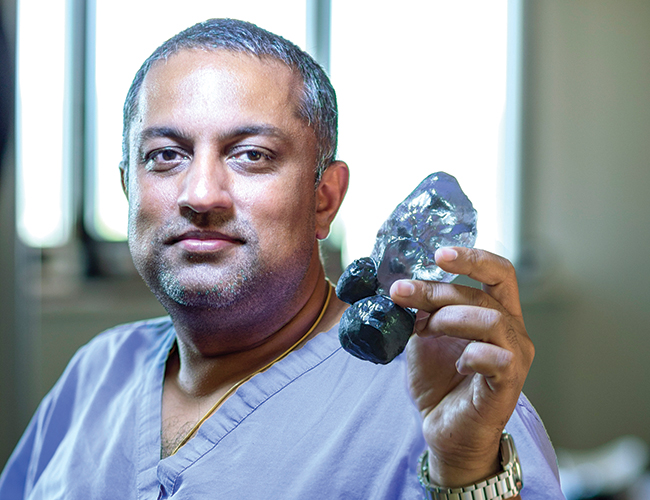Imagine a kidney cancer procedure that removes cancerous tissue while leaving the rest of the kidney intact. At Erlanger Health System, that procedure is a reality.
In the past, if a cancerous spot were found on a kidney, the entire kidney was removed. In the last few decades, however, researchers have found that organ-sparing surgeries are often equally effective and, in fact, increase quality of life for patients.
“Twenty to 30 years ago, the concept in cancer treatment was that more was better,” said Amar Singh, M.D., chair of the department of Urology at UT College of Medicine, Chattanooga. “The more you took out, organ-wise, the better. That has shifted — now we take the cancer out but preserve the organ.”
To envision the difference between a traditional kidney cancer surgery (radical nephrectomy) and an organ-sparing one (partial nephrectomy), consider an analogy Dr. Singh offers.
“If I gave you a potato and it had a rotten area, traditionally, we’d throw the whole potato away,” Dr. Singh said. “Now we carve the rotten area out, leaving the rest of the potato behind.”
Pioneering the procedure
Erlanger Health System began offering kidney-sparing surgery in 2007. In the last five years, surgeons at the health system, including Dr. Singh, have performed more than 100 partial nephrectomies each year — a number that places them among the top hospitals in the nation.
“Partial nephrectomy is where we’ve made our name,” Dr. Singh said. “Among kidney cancer surgical procedures nationally, the use of partial nephrectomy is about 30 percent. At Erlanger Health System, it makes up about 70 or 80 percent of our total kidney cancer procedures.”
The benefits of partial nephrectomy
To understand why leaving the kidney intact is so significant, it’s important to understand the dynamics of kidney cancer itself.
“The dilemma in kidney cancer is that younger and younger people are now being diagnosed,” Dr. Singh said. “Imagine a 45-year-old who is diagnosed with kidney cancer. If the entire kidney is removed and the patient experiences advanced disease down the road, he won’t be able to undergo the most advanced treatments, such as chemotherapy. Ultimately, you want to preserve renal function.”
Partial nephrectomy can often be performed robotically, which has additional benefits for patients.
“The concept of minimally invasive surgery is ‘can we do what we need to do without cutting you open from one side to the other?’” Dr. Singh said. “Can we do the procedure through a smaller incision? Robotic surgery helps us to accomplish that. The real-time movements of the surgeon are mimicked by an instrument about half an inch in size, and the surgeon can view the surgical area via a high-definition screen while performing the surgery.”
Patients who undergo robot-assisted surgery experience a variety of benefits, including a faster recovery and shorter hospital stays. With robotic surgery, patients typically go home the day following surgery, while those undergoing an open partial nephrectomy (requiring a larger incision) most often go home after three or four days.
“Our No.1 priority in kidney cancer surgery is cancer control,” Dr. Singh said. “No.2 is organ preservation, and No.3 is if we can do it in a minimally invasive way, that’s great.”
Leading the way
“More is not always better,” Dr. Singh said. “Organ preservation should be a key part of any type of surgery performed. At Erlanger Health System, that’s our emphasis. Data has shown that higher volume centers that perform these types of procedures have better outcomes overall. We’re leading the way in the Southeast.
“We’re not just thinking about the patient’s life at the current moment. We’re considering how the procedure will impact the patient’s quality of life five or 10 years from now. That’s the difference.”
Erlanger Health System offers comprehensive cancer care services. Learn more about the services we provide.







